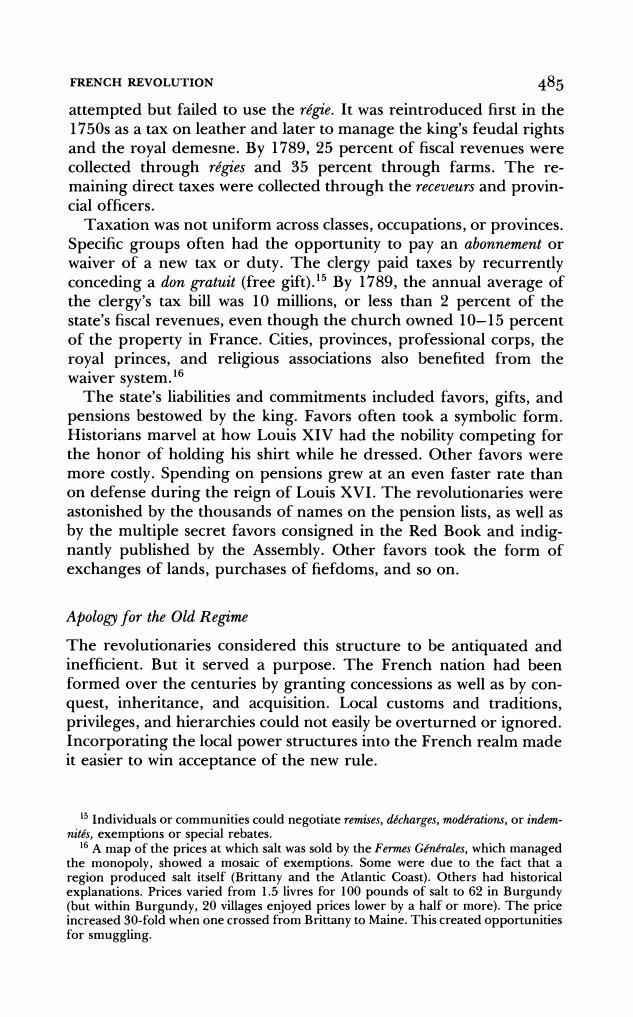正在加载图片...

FRENCH REVOLUTION 485 attempted but failed to use the regie.It was reintroduced first in the 1750s as a tax on leather and later to manage the king's feudal rights and the royal demesne.By 1789,25 percent of fiscal revenues were collected through regies and 35 percent through farms.The re- maining direct taxes were collected through the receveurs and provin- cial officers. Taxation was not uniform across classes,occupations,or provinces. Specific groups often had the opportunity to pay an abonnement or waiver of a new tax or duty.The clergy paid taxes by recurrently conceding a don gratuit(free gift).15By 1789,the annual average of the clergy's tax bill was 10 millions,or less than 2 percent of the state's fiscal revenues,even though the church owned 10-15 percent of the property in France.Cities,provinces,professional corps,the royal princes,and religious associations also benefited from the waiver system.16 The state's liabilities and commitments included favors,gifts,and pensions bestowed by the king.Favors often took a symbolic form. Historians marvel at how Louis XIV had the nobility competing for the honor of holding his shirt while he dressed.Other favors were more costly.Spending on pensions grew at an even faster rate than on defense during the reign of Louis XVI.The revolutionaries were astonished by the thousands of names on the pension lists,as well as by the multiple secret favors consigned in the Red Book and indig- nantly published by the Assembly.Other favors took the form of exchanges of lands,purchases of fiefdoms,and so on. Apology for the Old Regime The revolutionaries considered this structure to be antiquated and inefficient.But it served a purpose.The French nation had been formed over the centuries by granting concessions as well as by con- quest,inheritance,and acquisition.Local customs and traditions, privileges,and hierarchies could not easily be overturned or ignored. Incorporating the local power structures into the French realm made it easier to win acceptance of the new rule. s Individuals or communities could negotiate remises,decharges,moderations,or indem- nites,exemptions or special rebates. 16 A map of the prices at which salt was sold by the Fermes Generales,which managed the monopoly,showed a mosaic of exemptions.Some were due to the fact that a region produced salt itself (Brittany and the Atlantic Coast).Others had historical explanations.Prices varied from 1.5 livres for 100 pounds of salt to 62 in Burgundy (but within Burgundy,20 villages enjoyed prices lower by a half or more).The price increased 30-fold when one crossed from Brittany to Maine.This created opportunities for smuggling.FRENCH REVOLUTION 485 attempted but failed to use the regie. It was reintroduced first in the 1750s as a tax on leather and later to manage the king's feudal rights and the royal demesne. By 1789, 25 percent of fiscal revenues were collected through regies and 35 percent through farms. The remaining direct taxes were collected through the receveurs and provincial officers. Taxation was not uniform across classes, occupations, or provinces. Specific groups often had the opportunity to pay an abonnement or waiver of a new tax or duty. The clergy paid taxes by recurrently conceding a don gratuit (free gift)."5 By 1789, the annual average of the clergy's tax bill was 10 millions, or less than 2 percent of the state's fiscal revenues, even though the church owned 10-15 percent of the property in France. Cities, provinces, professional corps, the royal princes, and religious associations also benefited from the waiver system.'6 The state's liabilities and commitments included favors, gifts, and pensions bestowed by the king. Favors often took a symbolic form. Historians marvel at how Louis XIV had the nobility competing for the honor of holding his shirt while he dressed. Other favors were more costly. Spending on pensions grew at an even faster rate than on defense during the reign of Louis XVI. The revolutionaries were astonished by the thousands of names on the pension lists, as well as by the multiple secret favors consigned in the Red Book and indignantly published by the Assembly. Other favors took the form of exchanges of lands, purchases of fiefdoms, and so on. Apology for the Old Regime The revolutionaries considered this structure to be antiquated and inefficient. But it served a purpose. The French nation had been formed over the centuries by granting concessions as well as by conquest, inheritance, and acquisition. Local customs and traditions, privileges, and hierarchies could not easily be overturned or ignored. Incorporating the local power structures into the French realm made it easier to win acceptance of the new rule. 15 Individuals or communities could negotiate remises, decharges, modgrations, or indemnites, exemptions or special rebates. 16 A map of the prices at which salt was sold by the Fermes Gingrales, which managed the monopoly, showed a mosaic of exemptions. Some were due to the fact that a region produced salt itself (Brittany and the Atlantic Coast). Others had historical explanations. Prices varied from 1.5 livres for 100 pounds of salt to 62 in Burgundy (but within Burgundy, 20 villages enjoyed prices lower by a half or more). The price increased 30-fold when one crossed from Brittany to Maine. This created opportunities for smuggling